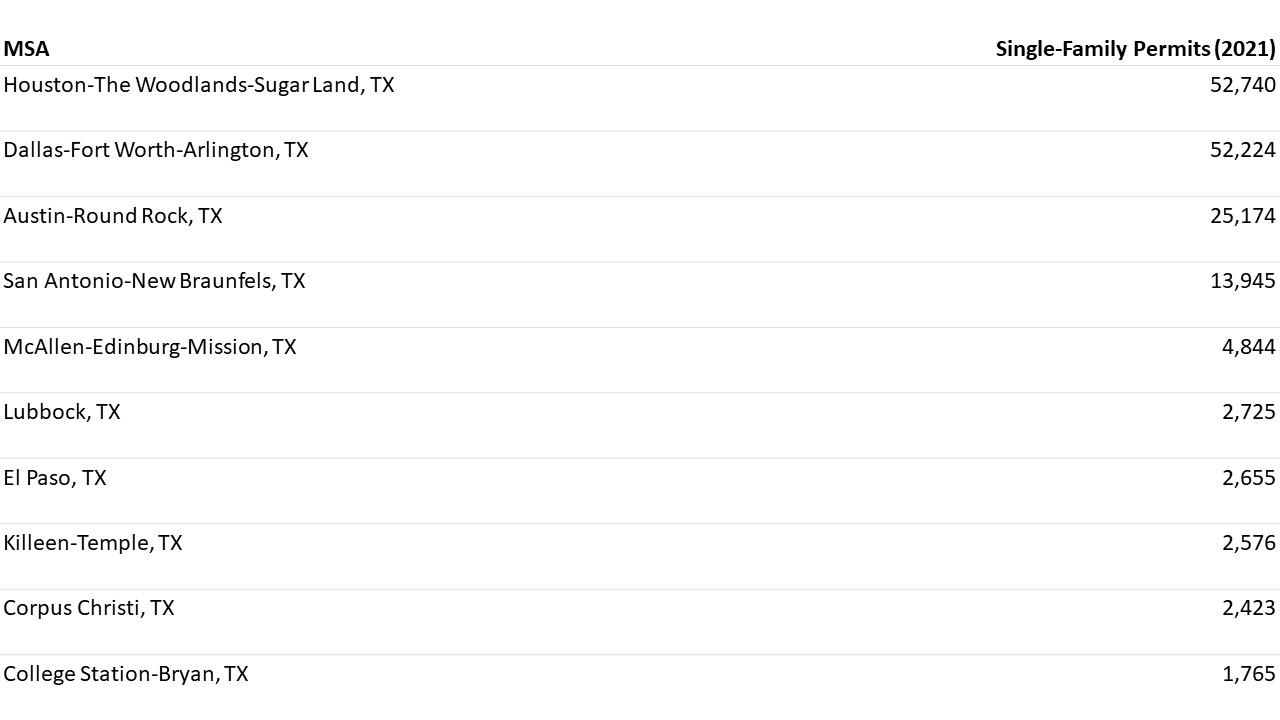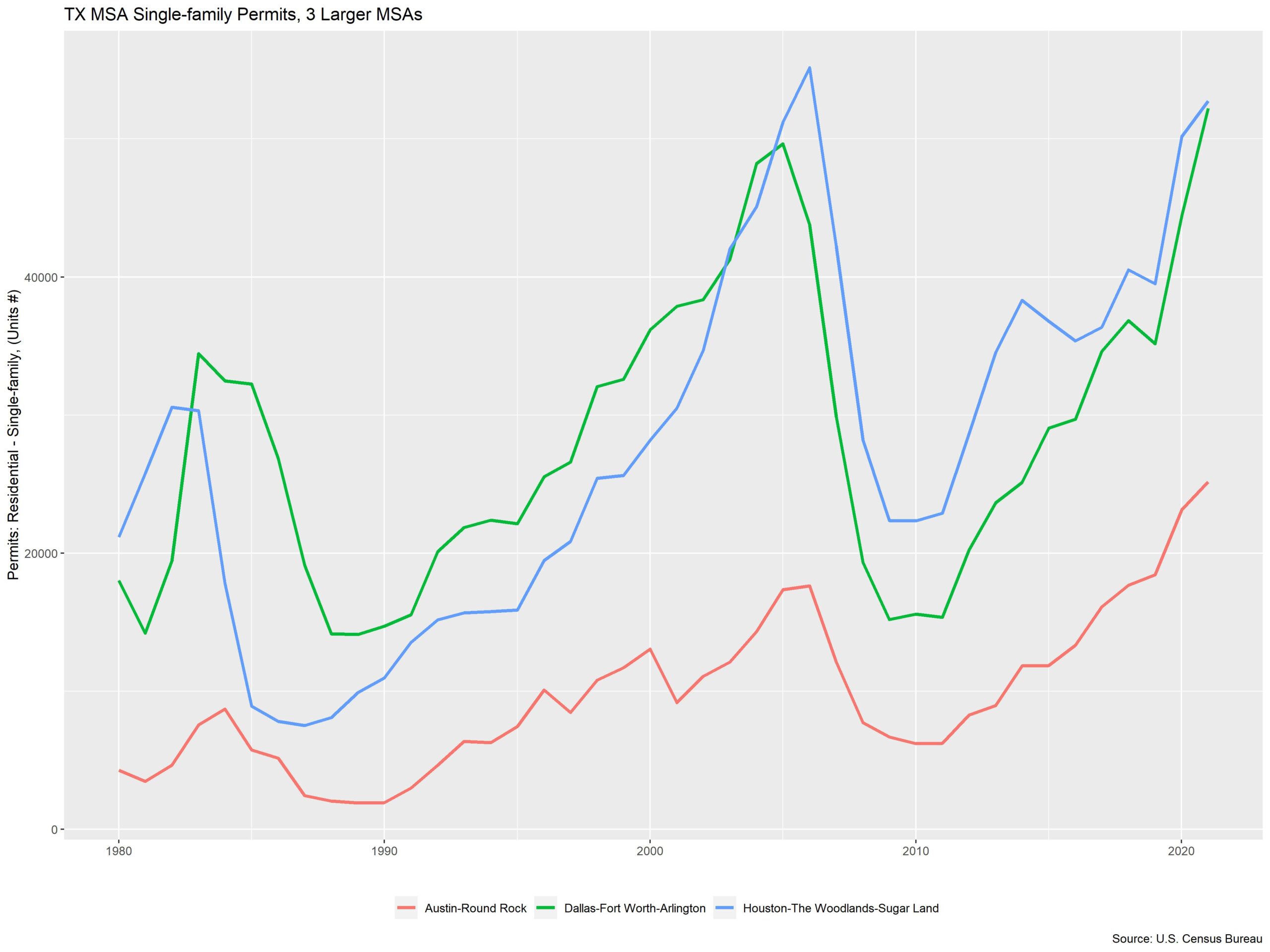Based on the Census Bureaus’ latest estimates, the population of the State of Texas grew by 470,708 persons between 2021 and 2022. This nominal increase was the largest of any state. Texas joined California as the second state to have a total population above 30 million, with a total estimated population of 30,029,572 on July 1, 2022. This population growth has supported strong growth for home building.

Within Texas, the Census designates 25 Metropolitan Statistical Areas. Four MSAs had a population above 2 million in 2021 (most recent available data at the MSA level). The Dallas-Fort Worth-Arlington and Houston-The Woodlands-Sugar Land are the 4th and 5th largest MSAs in the US.

Single-family permitting within Texas follows a similar ranking as population, with the exception of College Station-Bryan and Lubbock both joining the top ten. While the San Antonio-New Braunfels has approximately 250,000 more in population than Austin-Round Rock, Austin-Round Rock authorized 11,229 more permits than San Antonio-New Braunfels in 2021.

Single-family permits per capita is a statistic that we can use to compare the different MSAs of Texas. With the total number of single-family permits, we are unable to compare MSAs on an equal level because areas with higher populations almost always have more single-family permits. In the section below, we take a closer look at the ten MSAs that had the highest single-family permits per capita in 2021.
Top 10 MSAs by Single-Family Permits Per Capita
The ten highest permits per capita per MSA in 2021 are all displayed in the map above along with their 2021 total single-family permits and population estimates.
Three of the four largest MSAs in Texas had the ten highest permits per capita. Austin-Round Rocks’ ratio was 0.011 permits per capita, the highest of any MSAs in Texas. This is approximately 1 permit for every 93.4 persons in Austin-Round Rock. The ratio is 0.002 higher than the next highest ratio of permits per capita, which is 0.009 in Odessa.

The plot below shows the median population growth rate across the ten MSAs. All of the ten MSAs have a positive median growth rate, consistent with broad state population growth. The last time the state posted a yearly population decline was in 1949(-0.04%). Austin-Round Rock had the highest median growth rate of the MSAs at 3.15% over the 41-year period, and is the only MSA of the ten with a median above 3.00%. Dallas-Fort Worth-Arlington median growth rate was 2.20%, slightly higher than Houston-The Woodlands-Sugar Land at 2.09%. Lubbock, Corpus Christi, and Odessa had median growth rates below 1.00%.

Total single-family permits in Texas for the ten MSAs is again similar to their population rankings. The Houston-The Woodlands-Sugar Land has permitted consistently on a higher basis than Dallas-Fort Worth-Arlington since 2005, despite both MSAs having similar population growth over the past 40 years. In 2021, the gap between the two MSAs shrunk to 516 permits.

Dallas-Fort Worth-Arlington and Houston-The Woodlands-Sugar Land have authorized the most permits due to being significantly larger than other MSAs in Texas. They both reached a prior peak in 2005-2006 during the pre-Great Recession housing boom. Dallas-Fort Worth-Arlington did surpass this peak in 2021 while Houston-The Woodlands-Sugar Land is just short of these pre-Great Recession levels. Austin-Round Rock, the MSA with the highest population growth rate, passed their 2005-2006 peak in 2018.



The chart above details median permit per capita between 1980 and 2021. Despite having slightly lower median growth rates, the largest MSAs emerge as having the best median permitting per capita rates. In Austin-Round Rock, the median permits per capita ratio was 0.007. Houston-The Woodlands-Sugar Land had the second highest median with .005, slightly higher than permit per capita of Dallas-Fort Worth-Arlington.

These top ten permits per capita MSAs in Texas have mostly followed the same yearly trends as their total single-family permits measures. Around the 1980s, all MSAs except for Laredo and Sherman-Denison experienced a sharp drop in permits per capita. The ratio then grew to new highs by 2005-2006 for many of the MSAs. These highs gave way during the Great Recession when all permit per capita ratios fell, except for Odessa. Throughout the 2010s, the permit per capita ratios for these ten MSAs steadily increased to their current levels. Austin-Round Rock has consistently had the highest permits per capita ratio since 2014 for all the Texas MSAs.
Discover more from Eye On Housing
Subscribe to get the latest posts sent to your email.
